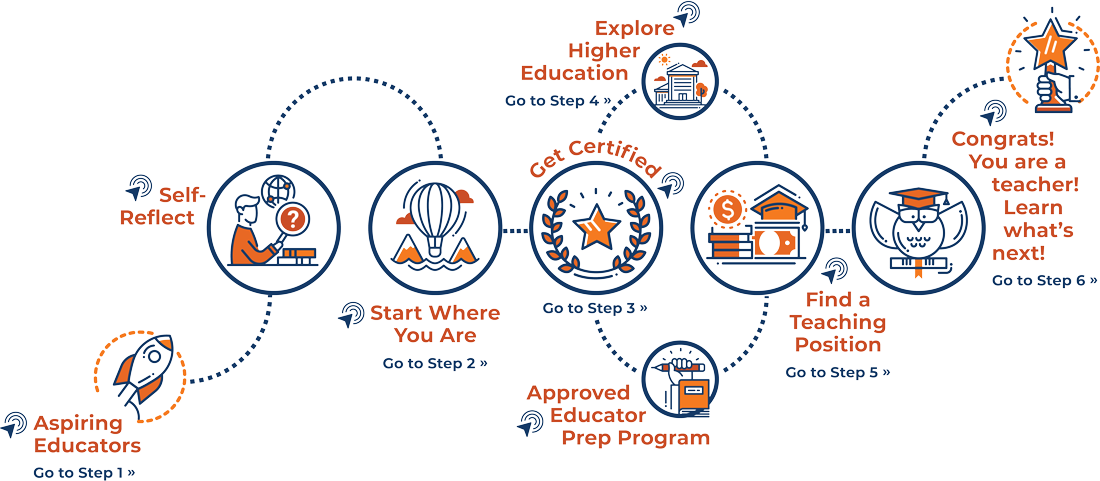Becoming a teacher is a big but rewarding commitment.
Where to begin? Let us help clear things up!
There are many factors to consider on your path to becoming a teacher. These steps can help you on your journey from aspiring educator to certified teacher.

Aspiring Educators
Connect with the career. Interview current educators and consider your own experiences and passion.
Does This Sound Like You?
- I am looking for a rewarding career that provides a strong sense of duty and opportunity.
- I enjoy connecting and interacting with others.
- I am responsive to the needs of others and want to positively impact my community.
- I am passionate about a subject or a particular interest and want to share that passion with others in a creative and energetic environment.
Start where you are!
Learn about the many routes to certification.
Get Certified!
What do you want to teach? Who do you want to teach? Where do you want to teach? How do you increase your potential?
Explore Higher Education Institutions
Having trouble choosing a school? Let us help!
Learn About Approved Educator Prep Programs
Traditional Teacher Certification Program
- Provides pre-service teachers with valuable pedagogy
- Rich student teaching experience
- Connects pre-service teachers to the teaching community
- Opportunity to pair with and receive guidance through a strong veteran teacher mentor
- Opportunity to learn from experts in the field
- Offers time to observe master teachers and put new skills to use in a safe and collaborative environment.
- Most traditional programs offer opportunity for pre-service teachers to engage in the components of planning and preparation, classroom environment, and instruction
Alternative Teacher Certification Program
- Swift, intensive route to the classroom
- Little to no opportunity to practice new skills before being submerged into the classroom
- Little to no classroom experience
- Little to no training in pedagogy
- No student teaching experience
Find a Teaching Position
- Network!
- Find the Jobs!
- Make your resume snazzy!
- Get Noticed!
Congratulations!
You are a teacher! Learn how to grow and contribute to the field.
STEP 1: Connect with the Career
If you’re considering a career in teaching, a great first step is interviewing current educators to learn more about their experiences and recommendations. If it sounds like the right career for you, consider your own experiences and passions to determine what you would like to teach. The grade level and subject you want to teach will determine the teaching certificate you will seek.
Ask Yourself:
What grade level most interests me?
What subject area keeps me inspired?
What types of learners do I want to impact?
Step 2: Start Where You Are
Whether you’re a recent high school graduate, a college graduate or an educator seeking national board certification, there’s a specific path to obtaining the teacher certification you desire. Continue reading and use the interactive graphic below to help identify your next steps on the path to becoming a teacher.
Funding My New Adventure

Get Started: Select Your Current Situation Below
- High School Graduate
- College Graduate
- National Board Certified Teachers
- Certified Outside of Texas
- Seeking Additional Certifications
SITUATION: You are in high school or have recently graduated and you are ready to begin your journey to becoming a teacher. You can complete a traditional teacher certification program at a University or college.
PATHWAY: An approved teacher preparation program.You can obtain your teacher certification by:
- Earning a bachelors degree from an approved teacher certification program. Each university may have slightly different requirements. Find out individual university requirements by visiting the university’s college of education webpage or making an appointment with one of their academic advisors.
- Passing the Texas state teacher certification exam.
ADVANTAGE: A degree grounded in strong teaching pedagogy
- Access to some of the most respected educators in the field as mentors during their field work.
- Opportunity practice teaching while connect theory to practice under the supportive eye of a university field supervisor and a master cooperating teacher.
SITUATION: You currently hold a bachelors degree and would like to go back to school to obtain a teacher certification. You are seeking certification and you are NOT seeking a degree or you are seeking an additional degree
PATHWAY: Approved teacher preparation program. You can obtain your teacher certification by:
- Applying to a university
- Meeting with an academic advisor
- Taking any content-specific courses needed for teacher education program entrance
- Enrolling in and complete the teacher certification program
- Applying to a post-baccalaureate or alternative certification program
- Look up application requirements for local programs (some are online and some are face-to-face)
- Attend classes in evenings, weekends, summers, and some evenings after school
- Fulfill a minimum of 30 hours of field based work
- Passing the Texas state teacher certification exam
SITUATION: You possess a certificate from the National Board for Professional Teaching Standards.
PATHWAY: National Board Certification
Just under 3% of the nation’s teachers are Nationally Board Certified. This certification is a voluntary advanced teaching credential that goes beyond state licensure. Many states accept this as proof for state licensure enabling teachers to move from state to state without having to obtains teaching credentials in each state.
There are currently 1,201 Nationally Board Certified teachers in Texas and 1,534 TX candidates for National Board Certification. A number of school districts and professional organizations in Texas provide stipends to Nationally Board Certified teachers. More information →
SITUATION: You completed a teacher certification program in another state and you are now wanting to teach in Texas.
PATHWAY: Texas Education Agency (TEA) review of credentials. You can obtain your teacher certification by:
- Complete an application and submit all official transcripts and certifications to the TEA for a review of credentials.
- Upon review, the TEA will send additional information regarding next steps for a one-year non-renewable certificate. Some exemptions are aloowable based on the review.
- After all requirements are met, application for a Texas standard certification must be submitted.
SITUATION: You possess a teacher certification in Texas and are interested in becoming certified in an additional subject
PATHWAY: Approved teacher certification exam. You can obtain your teacher certification by:
For most standard initial teaching certificates (SITC), once you have a SITC, you can simply test in another content area for certification (an exception to this is the new EC-3 certificate).
Step 3: Get Certified
Certifications & Choosing a Career Path
How you choose to become certified has a proven impact on your students’ scores, how long you stay in the field and your personal success as an educator.
TEA Certification Overview
By Region
Where would you like to go? Explore all the regions in Texas where you can teach.
By Certification
What would you like to teach? View a list of approved educator prep programs.
Who Do I Want to Teach?
What Should I Teach?
Increase Your Potential
Once you attain a Standard Initial Teaching Certificate, you can usually test to add a certification in another content area (the exception is the new EC-3 certificate). Think big picture about your future, and where and how you want to make the biggest impact.
Take it to the Bank
In addition to your teaching salary, you can increase your earning potential by leading a student organization, supporting on-campus extra-curricular activities and becoming a grade level lead or department head.
Certifications: Facts with Impact
There are advantages to choosing a traditional certification program. Read below to see some ways in which alternatively certified teachers measure up to those who take a more traditional path.
Preparation Pays Off
Research has shown that well-prepared teachers consistently produce higher student achievement gains.
Take the Long View
Teachers certified via traditional certification programs complete important preparation steps prior to the first year of teaching.
Certification Options
Consider the differences between traditional and and alternative teacher certifications.
Weigh the Pros and Cons »
Step 4: Find the Right College for You!
Each University of Texas College of Education offers a difference experience. View schools by the specialties they offer OR match a region to your interests.
Step 5: Find a Teaching Position
Looking for a teaching position can feel overwhelming – here are a few tips that can help you land your dream teaching job.
Network
Find the Jobs
Locating vacancies can be a rigorous task so consider how to find multiple opportunities at one time:
- Attend job fairs through local districts and education service centers
- Use social media to network and find openings
- Visit Texas educator job sites →
- Visit the TASA Career Center to find a current list of available jobs in Texas →
Make Your Resume Snazzy
Your resume and portfolio show what you have done, but as a new teacher, you may feel like you don’t have much to show. Transcripts, recommendations, examples of work from your student teaching experience and your philosophy of education will enhance your resume and portfolio to capture the attention of those hiring. Remember to personalize your cover letter by including what inspires you to become a teacher!
Get Noticed
- Be strategic about your certifications. Math, special education, STEM, and bilingual teachers are in great demand. Holding one of these certifications makes you more marketable.
- Consider starting your teaching career in rural or remote regions of Texas that are experiencing teacher shortages. Some more remote locations may even offer sign-on bonuses.
- Once you have landed an interview, study up! Gather as much information as you can about the school, including an understanding of the school’s mission, the mascot, specific programs the school may offer, the demographics of the community, as well as accountability ratings and areas of success and improvement as identified by state accountability test scores. The more you know, the more confident you will feel!
- Practice for the interview! Gather family and trusted friends and practice your interview skills from introduction to conclusion.
Money Matters: Investing in Your Career
The median income for a teacher is approximately $62,038 per year. However, schools often pay teachers stipends for teaching additional classes during the school year, being certified in high-needs areas such as special education and English as a second language, and for teaching outside of school hours, such as summer school. Many teachers also receive additional stipend money for being a club sponsor or coaching a sport. Teacher leaders, such as department heads and lead teachers, commonly receive compensation for this work as well.
ESL & SPED Certifications: Increase your Potential
English as a Second Language (ESL)
Teachers in PK-12 require an ESL certificate to work with English Language Learners (ELLs). Earning an ESL certificate may provide more teaching opportunities.
Special Education (SPED)
A SPED certificate prepares teachers to meet the needs of students with varying disabilities. This ensures teachers know how to differentiate lessons and instruction based on individual needs.
ESL & SPED
These certifications better prepare future teachers and may provide more teaching opportunities. Teachers holding these certifications are sometimes provided one-time or annual financial incentives.
Step 6: Growing and Contributing to the Profession
Professional Development
Great teachers seek ongoing professional development. High standards for students first start with high standards for teachers. Here are a few ways you can keep growing and even contribute to the growth of others:
- Consider attending and presenting at education conferences, joining state and national education organizations and keeping up with the latest education journals.
- Connect with your regional Education Service Center. These provide a tremendous amount of support and professional development to educators.
Interested in growing your career?
Visit our Continuous Development section for education organizations and resources.
Interested in a career in education? Let us help!
ADDRESS
210 West 7th Street
Austin, Texas 78701-2982
We take your privacy seriously and will not use the information you provide for purposes other than those needed to contact you about participation in ElevateTXed. You may opt out of receiving occasional emails from ElevateTXed at any time by clicking here. For more information about the information we collect and why we collect it, please review our Privacy Policy. By clicking, Submit, you certify that you have read the above statement and agree to provide the information requested above to contact ElevateTXed.








